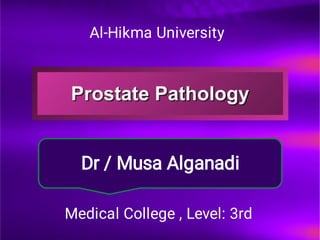
Prostate Pathophysiology23.ppt prostate cancer prostatic hyperplasia
- 1. Dr / Musa Alganadi Al-Hikma University Medical College , Level: 3rd
- 3. Introduction Normal Structure of Prostate: The prostate gland in the normal adult weighs approximately 20 gm. It surrounds the commencement of the male urethra and is composed of 5 lobes during embryonic development— anterior, middle, posterior and two lateral lobes. But at birth, the five lobes fuse to form 3 distinct lobes—two major lateral lobes and a small median lobe
- 4. Introduction The prostate has numerous blood vessels and nerves. In addition to nervous control, the prostate is an endocrine dependent organ. Based on hormonal responsiveness, the prostate is divided into 2 separate parts: 1- The inner periurethral female part which is sensitive to oestrogen and androgen. 2- The outer subcapsular true male part which is sensitive to androgen.
- 5. Introduction Histology of Prostate: the prostate is composed of tubular alveoli (acini) embedded in fibromuscular tissue mass. The glandular epithelium forms infoldings and consists of 2 layers: 1- A basal layer of low cuboidal cells 2- An inner layer of mucus-secreting tall columnar cells. The alveoli are separated by thick fibromuscular septa containing abundant smooth muscle fibres.
- 8. Pathology of Prostate Prostate is involved in 3 important pathologic processes: prostatitis, nodular hyperplasia and carcinoma. While benign nodular hyperplasia occurs in the periurethral part distorting and compressing the centrally located urethral lumen, the prostatic carcinoma usually arises from the outer subcapsular part in which case it does not compress the urethra.
- 9. NODULAR HYPERPLASIA • Non-neoplastic tumour-like enlargement of the prostate, commonly termed benign nodular hyperplasia (BNH) or benign enlargement of prostate (BEP) • Is a very common condition in men and considered by some as normal ageing process. • More frequent above the age of 50 years and its incidence approaches 75-80% in men above 80 years.
- 10. NODULAR HYPERPLASIA ETIOLOGY : The cause of BEP has not been fully established. However, a few etiologic factors such as endocrinologic, racial, inflammation and arteriosclerosis have been implicated but endocrine basis for hyperplasia has been more fully investigated and considered a strong possibility in its genesis.
- 11. NODULAR HYPERPLASIA The periurethral inner prostate which is primarily involved in BEP is responsive to the rising level of oestrogen, whereas the outer prostate which is mainly involved in the carcinoma is responsive to androgen.
- 12. NODULAR HYPERPLASIA MORPHOLOGIC FEATURES : Grossly, the enlarged prostate is nodular, smooth and firm and weighs 2-4 times its normal weight i.e. may weigh up to 40-80 gm. The appearance on cut section varies depending upon whether the hyperplasia is predominantly of the glandular or fibromuscular tissue.
- 13. NODULAR HYPERPLASIA MORPHOLOGIC FEATURES : In primarily glandular BEP the tissue is yellow-pink, soft, honey-combed, and milky fluid exudes, whereas in mainly fibromuscular BEP the cut surface is firm, homogeneous and does not exude milky fluid. The hyperplastic nodule forms a mass mainly in the inner periurethral prostatic gland so that the surrounding prostatic tissue forms a false capsule which enables the surgeon to enucleate the nodular masses.
- 16. NODULAR HYPERPLASIA MORPHOLOGIC FEATURES : Histologically, in every case, there is hyperplasia of all three tissue elements in varying proportions—glandular, fibrous and muscular. Glandular hyperplasia predominates in most cases and is identified by exaggerated intra-acinar papillary infoldings with delicate fibrovascular cores. The lining epithelium is two-layered: the inner tall columnar mucus-secreting with poorly-defined borders, and the outer cuboidal to flattened epithelium with basal nuclei.
- 17. NODULAR HYPERPLASIA MORPHOLOGIC FEATURES : Fibromuscular hyperplasia when present as dominant component appears as aggregates of spindle cells forming an appearance akin to fibromyoma of the uterus. In addition to glandular and/or fibromuscular hyperplasia, other histologic features frequently found include foci of lymphocytic aggregates, small areas of infarction, corpora amylacea and foci of squamous metaplasia.
- 18. Nodular hyperplasia of the prostate. There is hyperplasia of fibromuscular elements. There are areas of intra-acinar papillary infoldings (convolutions) lined by two layers of epithelium with basal polarity of nuclei.
- 32. Prostate Cancer Prostate cancer represents the second most common cancer in men worldwide and the fifth most common cause of cancer death in men; in the United States, it is the most common cancer in men and the second most common cause of cancer deaths in men. Acinar adenocarcinoma of the prostate comprises 90-95% of prostate cancers. Introduction
- 33. Types of Prostate Cancer 4 Types : 1. Latent carcinoma. 2. Incidental carcinoma. 3. Occult carcinoma. 4. Clinical carcinoma.
- 34. Morphologic Features Grossly : The prostate may be enlarged, normal in size or smaller than normal. In 95% of cases, prostatic carcinoma is located in the peripheral zone, especially in the posterior lobe. The malignant prostate is firm and fibrous. Cut section is homogeneous and contains irregular yellowish areas.
- 35. Morphologic Features Microscopically : 4 histologic types are described : adenocarcinoma, transitional cell carcinoma, squamous cell carcinoma and undifferentiated carcinoma. Adenocarcinoma is the most common type found in 90-95% of cases and is the one generally referred to as carcinoma of the prostate. The other three histologic types are rare
- 36. Etiology of Prostate Cancer The cause of prostatic cancer remains obscure. However, a few factors have been suspected. These are as under: 1. Endocrinologic factors. 2. Racial and geographic influences. 3. Environmental influences. 4. Nodular hyperplasia. 5. Heredity.
- 42. Other Histologic Types of Prostate Cancers